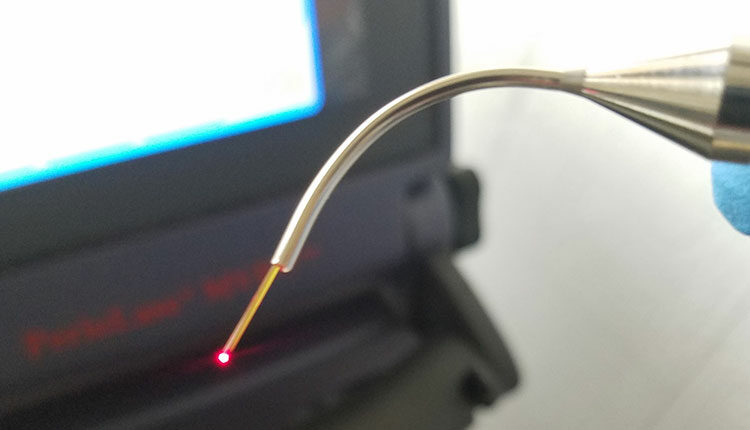 LOSROBLOS/ISTOCK/GETTY IMAGES PLUS
LOSROBLOS/ISTOCK/GETTY IMAGES PLUS
Perceptions of the LANAP Protocol
Survey results demonstrate clinicians’ satisfaction and perception of treatment success when utilizing the Laser Assisted New Attachment Procedure in periodontal care
EDITOR’S NOTE: Due to the nature of this survey data and analysis, the following content has not been peer reviewed.
Data is lacking relative to clinician satisfaction when utilizing the Laser Assisted New Attachment Procedure (LANAP) for treating periodontitis. Independent clinical outcomes of treatment success using LANAP are difficult to publish due to the fact most LANAP providers are independent dentists or periodontists working in small private clinics.
Among the factors that restrict an abundance of peer reviewed articles are the challenges of convening an institutional review board, statistical support, and the ethics of withholding treatment for study subjects diagnosed with periodontitis.
Accordingly, the study presented here surveyed trained LANAP providers about their satisfaction levels — as well as perceptions of treatment success — when utilizing the LANAP protocol in private practice. A series of multiple-choice questions, agreed upon and developed by the authors, were emailed to trained LANAP providers on five occasions over seven months. The questions were designed to gauge clinicians’ satisfaction with the LANAP protocol. These were subdivided into categories that included experience levels with the product (i.e., years of use), reasons for purchasing the laser used in the procedure (PerioLase MVP-7, Millennium Dental Technologies), and the indications for clinical use. The survey further queried providers about patients’ perceived satisfaction with the LANAP protocol over conventional periodontal therapies, such as scaling and root planing (SRP) and pocket reduction/guided tissue regeneration (GTR). It also asked about clinical results, patient comfort levels post-LANAP treatment, and whether clinicians would recommend the LANAP protocol to colleagues.
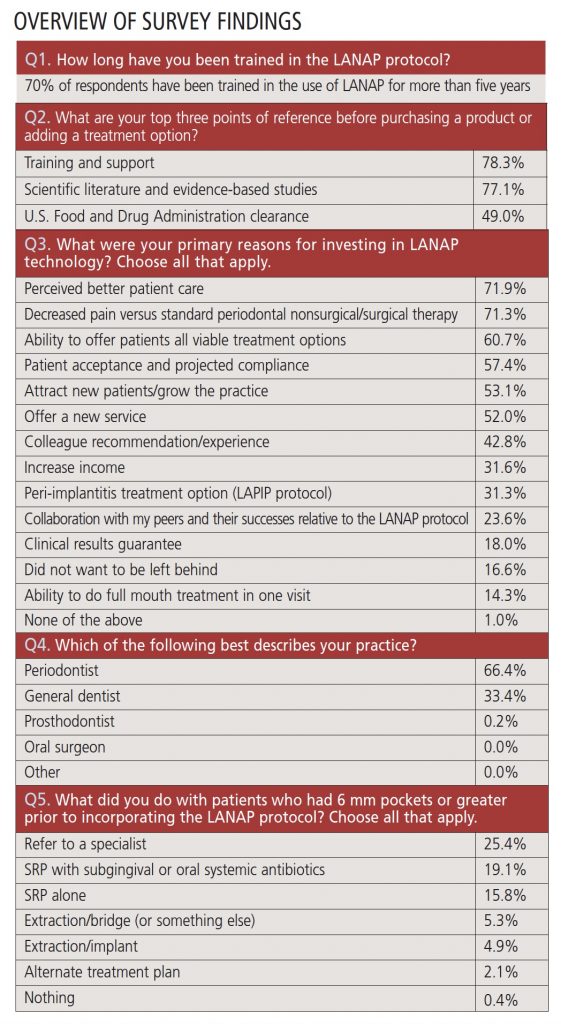
The data was compiled via a standardized intake portal (Survey Monkey) and exported to a Microsoft Excel file for statistical analysis at Rutgers School of Dental Medicine. The descriptive statistics were calculated and their values are presented here. Chi-square tests were used to compare the responses between periodontists and general dentists. Data analysis was conducted using statistical software (SAS version 9.4, SAS Institute). The significance level (two-sided) was set to 0.05 for all comparisons.
Of 2043 surveys sent, 512 respondents returned completed surveys, with a response rate of 25% (± 4%) at a 95% confidence level.
Discussion
The widespread prevalence of periodontitis, as well as its significant role in oral-systemic health,1,2 makes successful treatment of periodontal disease critically important. If a treatment is not predictable and successful, most clinicians will seek a more predictable and successful approach. Marketing research has demonstrated a measurable difference between what people state versus their thoughts about a new product.3 Logic also suggests that an independent, confidential user-satisfaction survey would generate objective feedback relative to the clinician’s actual perception of treatment success and satisfaction with the treatment modality, specifically the LANAP protocol.
The ethical balance that drives decisions to adopt new procedures or technologies is clearly apparent in the survey responses (Question 3). The top three points of reference that the respondents use before purchasing a product or adding a therapy protocol are balanced between wanting to ensure the efficacy of any new procedure as well as their ability to effectively implement and execute it.
The incorporation of patient-reported outcome measures (PROMs) as a key factor in assessing treatment options is gaining traction.4,5 Within implant dentistry, PROMs are becoming a standard part of developing treatment studies and protocols, and are likely to be included in future assessment of clinical studies. The top reasons for investing in LANAP technology center on the patient experience and increasing treatment options for periodontal disease. As PROMs relate to this study, respondents ranked the patient experience with the LANAP protocol overwhelmingly positive in the areas of:
-
![lanap questions]()
*click to enlarge Willingness to accept treatment
- Comfort level postoperatively
- Root sensitivity postoperatively
- Overall patient satisfaction
- Willingness to refer others for treatment
Compared with standard GTR protocols (as measured by pocket reduction, reduction of bleeding on probing and suppuration, with enhanced occlusal stability), more than 79% of LANAP clinicians have found this modality provides an equally predicable therapeutic outcome relative to periodontal regeneration. In addition, 41.7% of survey respondents state that LANAP is a more predictable procedure (Question 15). The reproducibility experienced by a significant number of LANAP clinicians, irrespective of years performing the protocol, suggests the bone fill visible in published LANAP case reports is a routine result. As the procedure has consistently yielded favorable outcomes, 71.7% of the respondents would elect to treat a previously treated LANAP patient with laser therapy (Question 17).
The survey showed statistically significant differences between general dentists and periodontists in the categories of reasons for purchase, points of reference for product purchase, and perceived disease recurrence rates. Despite their differing reasons for adding the LANAP protocol, both groups had remarkably similar satisfaction ratings of the results of the LANAP protocol, increases in production, and its impact on a positive patient experience.
Prior to purchase, 53.8% of general practitioners include return on investment as a key investment factor, as compared to 35.4% of periodontists. When financial return on a treatment is a key reason for incorporating it into practice, it stands to reason that clinician satisfaction will be influenced by both clinical results and financial return. General dentists ranked “perceived better patient care” as their No. 1 reason for adopting the LANAP protocol (84.2%), while periodontists ranked it third (69.0%). Colleague recommendation and “not being left behind” are much more important to periodontists than general dentists.
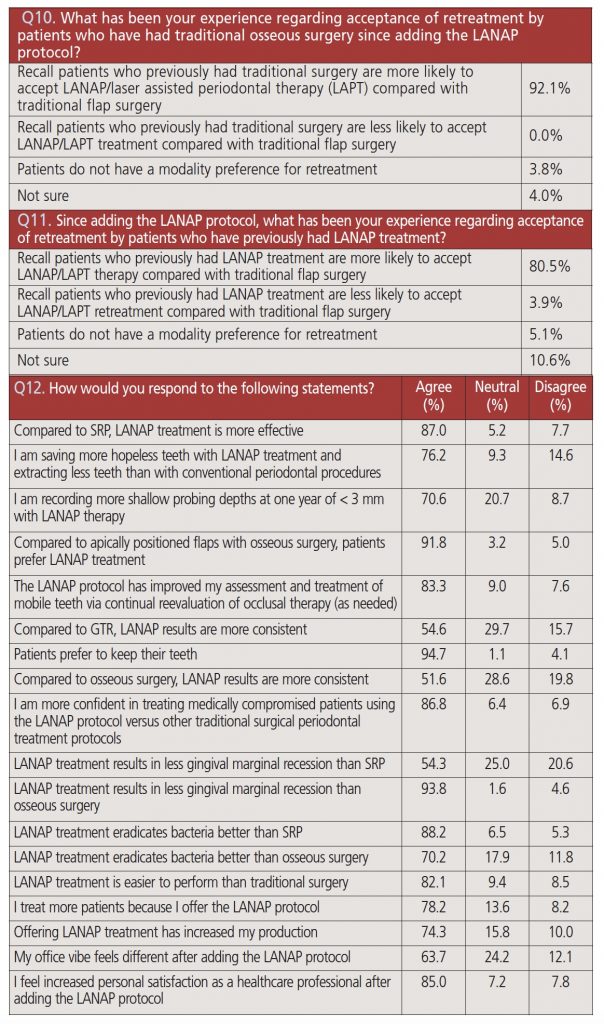
Both segments ranked training and support as a key point of reference in purchase decisions, and both also valued support in the scientific literature. While neither segment listed organizational reviews as a top reason for product adoption, these reviews are held in higher esteem by periodontists than general dentists (11.7% versus 4.7%, respectively). The American Academy of Periodontology released a statement on lasers in 2018,6 and LANAP research was not included in this document. In light of this, one of the reasons why this survey was conceptualized was to add to the dental literature relative to the efficacy of LANAP treatment and the consistently favorable nature of LANAP in regard to PROMs.
Significant differences in the perceived disease recurrence rates exist between various practitioners. The survey revealed 28.6% of periodontists report that disease recurrence rates after LANAP treatment were less than recurrence rates with flap surgery, while general dentists reported these recurrence rates at 70.8%. In addition, 55.6% of periodontists said disease recurrence rates were similar between LANAP and flap surgeries; however, only 25.6% of general dentists indicated the same. These differences could be based on subjective measurement, differences in diagnostic criteria, or understanding of root morphology based on periodontal residency training and flap surgical experience.
Differences between specialties are also noted in shallow probing depths at one year, consistency of results, ease of performance, and personal satisfaction. General dentists believe they are saving more hopeless teeth and feel increased personal satisfaction after adding the LANAP protocol, as compared to periodontists (87% versus 71%, and 95% versus 80%, respectively). However, both measurements exhibit inarguably positive responses. Both segments report similar, positive numbers for patients wanting to retain their teeth, an increase in production after adding LANAP as a treatment option, and a “different vibe” in their office.
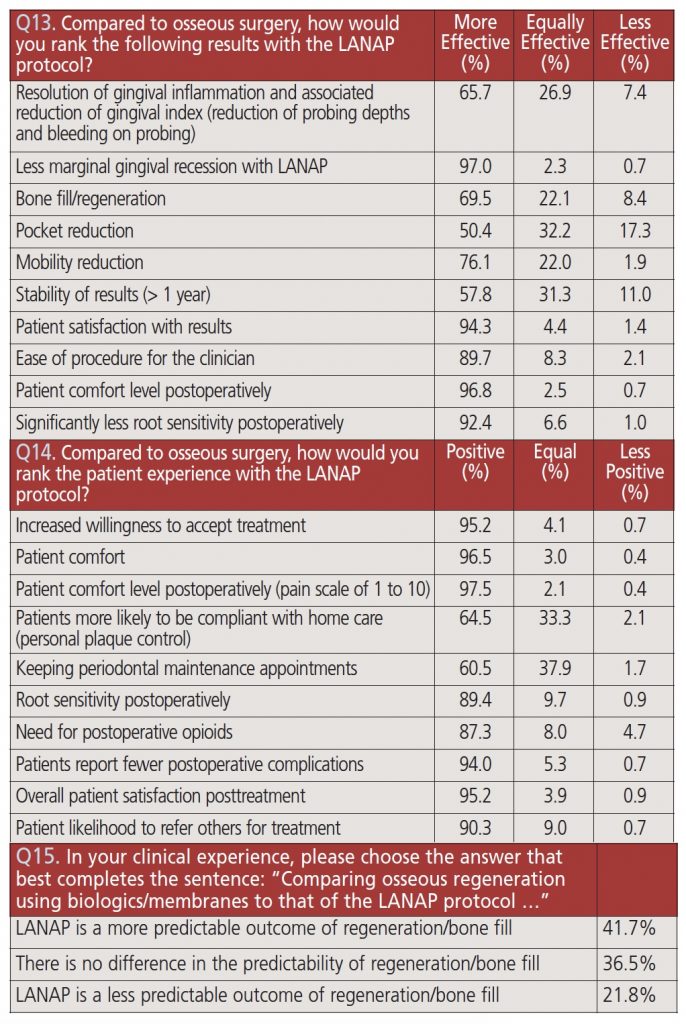
Specialty training or degree of experience in performing the LANAP protocol does not influence patients’ acceptance rates or postoperative experience. Cumulatively, more patients accept this periodontal treatment and are more satisfied postoperatively — which makes this a successful treatment modality, both subjectively and clinically. If the goals of treatment are greater case acceptance and successful outcomes, these are achieved more often when LANAP is added as a treatment option.7
It is important to stress that clinical endpoints for success with the LANAP protocol are similar to that of flap surgery from a periodontal assessment perspective. Pocket reduction, including decreases in probing depths, bleeding upon probing, tooth mobility and fremitus, is the ultimate long-term goal. LANAP therapy is either a closed or semi-closed surgical procedure. The authors, five of whom are periodontists with extensive surgical experience, believe that knowledge of root morphology is critical to success, as tooth roots have known concavities, various root trunk morphologies and furcation locations based on their position in the arch and which jaw is being treated. Thus, extensive knowledge of root anatomy, along with meticulous SRP and definitive occlusal therapy (i.e., mobility and fremitus reduction), are key to successful outcomes.
Lastly, long-term preventive periodontal maintenance is needed to preserve the positive results of treatment. Knowledge of when it is necessary to retreat an area with either LANAP or a surgical protocol (as necessary) should be part of any periodontal maintenance protocol. It is this combination of inflammatory and occlusal control, followed by a comprehensive preventive periodontal maintenance program individualized for each patient, that ultimately spells success in all periodontal case types (I through IV), and for all periodontal nonsurgical and surgical protocols.
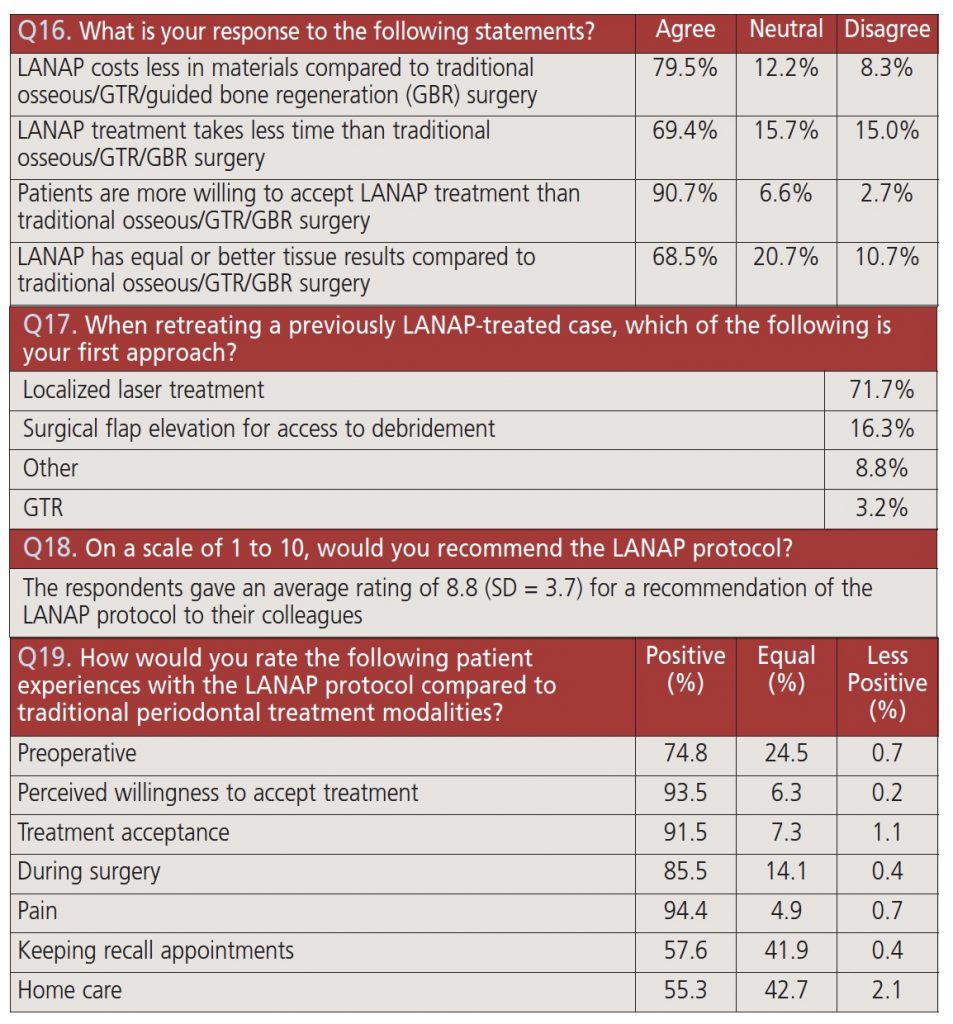
As a part of a comprehensive periodontal treatment plan, LANAP therapy yields consistent, predictable results that are at least comparable with other surgical modalities over time.8 The majority of survey respondents (53.6%) have performed LANAP treatment for a minimum of seven years. Of these clinicians, 87.9% indicated that LANAP results were equally stable or more stable than osseous surgery.
CONCLUSION
LANAP clinicians are highly satisfied with their perception of treatment success, independent of their specialty or experience with the protocol. The LANAP treatment is cost effective, has a higher patient acceptance rate, yields better tissue response, results in equal or more consistent regeneration, and increases the professional satisfaction of the clinician. Patients are happier, and report significantly reduced postoperative discomfort and increased motivation in maintaining their oral health with more diligent and conscientious plaque control (i.e., disease control).
Although these survey results are promising, randomized controlled trials are needed to further substantiate these findings.
References
- Beck JD, Philips KH, Rao SS. Periodontal disease and systemic interactions (periodontal medicine): current epidemiological evidence. Curr Oral Health Rep. 2020;7:54–61.
- Seitz MW, Listl S, Bartols A, et al. Current knowledge on correlations between highly prevalent dental conditions and chronic diseases: an umbrella review. Prev Chronic Dis. 2019;16:E132.
- The way the brain buys; the science of shopping. The Economist. 2008;389:105–107.
- Feine J, Abou-Ayash S, Al Mardini M, et al. Group 3 ITI Consensus Report: patient-reported outcome measures associated with implant dentistry. Clin Oral Implants Res. 2018;29(Suppl 16):270–275.
- Rosen EB, Donoff RB, Riedy CA. U.S. dental school deans’ views on the value of patient-reported outcome measures in dentistry. J Dent Educ. 2016;80:721–725.
- Mills MP, Rosen PS, Chambrone L, et al. American Academy of Periodontology best evidence consensus statement on the efficacy of laser therapy used alone or as an adjunct to non-surgical and surgical treatment of periodontitis and peri-implant diseases. J Periodontol. 2018;89:737–742.
- Miller PD, McEntire ML, Marlow NM, Gellin RG. Evidenced-based scoring index to determine the periodontal prognosis on molars. J Periodontal. 2014:85:214–225.
- Tilt LV. Effectiveness of LANAP over time as measured by tooth loss. Gen Dent. 2012;60:143–146.
From Decisions in Dentistry. November 2020;6(10):18, 21-23.



